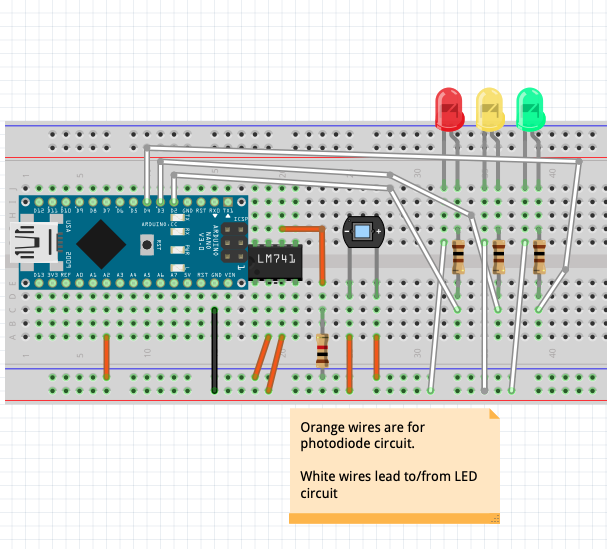Omari_Timmerman_-_District_Poster_2020.pdf
Jyesi and Omari used an arduino and photo diode to pick up the wavelengths o light. Set it up in the range of 450nm-490nm to specifically pick up on the light that bioluminescence is usually in. We ended up doing 3 versions and version 3 was the successful one. So our future plans are to make this waterproof do if you think you can help please contact me. Or just any additional information.
Current Build:

Current Code:
int sensorPin = A2;
int sensorValue = 0;
const int high = 15; //set high parameter
const int low = 5; //set low parameter
**
**
void setup(void) {
pinMode(A2, INPUT); //sensor
pinMode(2, OUTPUT); //red
pinMode(3, OUTPUT); //yellow
pinMode(4, OUTPUT); //green
Serial.begin(9600);
pinMode(sensorPin, INPUT);
}
**
**
void loop(void) {
sensorValue = analogRead(sensorPin);
float lightlevel = (sensorValue) * 5.0; //amplifying signal
Serial.print("Light Level: ");
Serial.print(lightlevel);
if (lightlevel < low) { //low, red light on
digitalWrite(2, HIGH);
digitalWrite(3, LOW);
digitalWrite(4, LOW);
Serial.println(" No Bioluminescence");
}
else if (lightlevel >= high) { //high, green light on
digitalWrite(2, LOW);
digitalWrite(3, LOW);
digitalWrite(4, HIGH);
Serial.println(" Bioluminescence");
}
else { //medium, yellow light on
digitalWrite(2, LOW);
digitalWrite(3, HIGH);
digitalWrite(4, LOW);
Serial.println("Low Bioluminescence");
}
delay(10);
}

3 Comments
@mimiss has marked @amallozzi as a co-author.
Reply to this comment...
Log in to comment
Put all inside a 1" plastic tube and fill it with 3M 8882 gel is most likely the simplest and cheapest way to get it waterproof.
Reply to this comment...
Log in to comment
I don't know if it's viable in this area or not. For blood analyzers, the approach one company was taking was photon counting. That was 15 years ago. That was for instruments that are chemiluminescent based, so they shouldn't be too far off. Don't know about the electronics involved.
Reply to this comment...
Log in to comment
Login to comment.